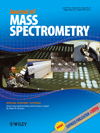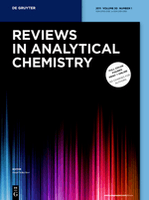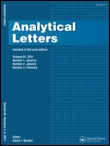
Analytical and Bioanalytical Chemistry Research
Scope & Guideline
Exploring Innovations in Chemical Analysis.
Introduction
Aims and Scopes
- Analytical Method Development:
The journal publishes research on the development of new analytical methods, including chromatography, mass spectrometry, and electrochemical techniques, aimed at improving detection sensitivity and selectivity. - Microextraction Techniques:
A significant focus is on innovative microextraction methods such as solid-phase microextraction, liquid-liquid extraction, and dispersive solid-phase extraction, which are crucial for sample preparation in trace analysis. - Nanomaterials in Analysis:
The use of nanomaterials for enhancing analytical performance, including the fabrication of electrochemical sensors and biosensors, is a recurring theme, highlighting the integration of nanotechnology in analytical chemistry. - Environmental and Food Safety Analysis:
Research addressing the determination of contaminants in environmental matrices and food products, including heavy metals and pesticides, reflects the journal's commitment to public health and safety. - Bioanalytical Applications:
The journal includes studies focused on bioanalytical chemistry, particularly in the quantification of drugs and biomolecules in biological samples, emphasizing the role of analytical chemistry in clinical settings.
Trending and Emerging
- Green Analytical Chemistry:
There is an increasing emphasis on environmentally friendly analytical techniques, such as green extraction methods and sustainable materials, reflecting a broader trend towards sustainability in analytical practices. - Integration of Machine Learning and AI:
The application of machine learning and artificial intelligence to optimize analytical methods and data analysis is gaining traction, indicating a shift towards more computational approaches in analytical research. - Advanced Sensor Development:
The trend towards developing advanced electrochemical and optical sensors, particularly those utilizing nanomaterials and molecularly imprinted polymers, highlights a growing interest in real-time and on-site analysis. - Multidisciplinary Approaches:
Research that integrates analytical chemistry with other disciplines, such as biochemistry and materials science, is increasingly common, showcasing the collaborative nature of contemporary scientific research. - Focus on Emerging Contaminants:
There is a rising trend in the analysis of emerging contaminants, such as pharmaceuticals and personal care products, reflecting heightened awareness of their environmental and health impacts.
Declining or Waning
- Traditional Analytical Techniques:
There is a noticeable decrease in the publication of studies focused solely on traditional analytical techniques without innovative enhancements, reflecting a shift towards more advanced methodologies. - Inorganic Analysis without Novel Approaches:
Research centered on basic inorganic analysis, particularly in the absence of novel extraction or detection methods, has become less common, possibly due to the increasing complexity and specificity required in contemporary analytical chemistry. - General Reviews on Established Methods:
The frequency of general review articles discussing established analytical methods has declined, indicating a preference for more targeted, innovative reviews that address specific challenges or advancements.
Similar Journals

JOURNAL OF ANALYTICAL CHEMISTRY
Shaping the Future of Analytical PracticesJOURNAL OF ANALYTICAL CHEMISTRY, published by PLEIADES PUBLISHING INC, stands as a pivotal resource in the field of analytical chemistry, offering an innovative platform for researchers, professionals, and students to advance their knowledge and contribute to the discourse within the discipline. With an ISSN of 1061-9348 and an E-ISSN of 1608-3199, this journal features a focused exploration of analytical methodologies, instrumentation developments, and applications across various domains, contributing to practical and theoretical advancements in the field. Currently ranked in the Q3 category in Analytical Chemistry with a Scopus rank of #111 out of 156, it provides critical insights and innovation strategies for professionals aiming to enhance their analytical capabilities. Access to the journal is through standard subscription models, and it covers an extensive range of topics pertinent to the discipline from 1996 to 2024. Engage with the JOURNAL OF ANALYTICAL CHEMISTRY to be part of a vibrant research community dedicated to push the boundaries of analytical practices.

Food Analytical Methods
To advance the frontiers of food analytical methodologies.Food Analytical Methods, published by Springer, is an esteemed journal dedicated to the innovative field of analytical methodologies within the food sciences. With an ISSN of 1936-9751 and E-ISSN of 1936-976X, this journal serves as a pivotal platform for researchers and professionals to exchange insights, methodologies, and findings related to food quality analysis, safety measures, and innovative technologies in food science. As of 2023, Food Analytical Methods boasts impressive Scopus rankings, including Q2 in Analytical Chemistry and Food Science, positioning it among the top journals in its category. The journal's commitment to enhancing food safety and quality through rigorous research underscores its importance in both academic and industrial applications. Although it does not currently operate under an open-access model, it provides exceptional value through its rigorous peer-review process and comprehensive publication standards, further inviting contributions from both established and emerging scientists in the field. With coverage spanning from 2008 to 2024, this journal continues to address critical research areas, thereby shaping the future of food analytics.

ATOMIC SPECTROSCOPY
Driving Progress in Spectroscopic Methodologies.ATOMIC SPECTROSCOPY is a distinguished journal specializing in the field of spectroscopy and published by ATOMIC SPECTROSCOPY PRESS LTD. With ISSN 0195-5373 and e-ISSN 2708-521X, this journal has been a cornerstone in advancing the discipline since its inception, thriving in its relevant domain for over four decades, covering converged research years from 1980 to 1989 and from 1996 to 2024. Currently holding a Category Quartile of Q2 in Spectroscopy for 2023, ATOMIC SPECTROSCOPY ranks 34th among 76 in its field according to Scopus, placing it in the 55th percentile, thereby affirming its critical role as a resource for researchers, professionals, and students alike. This journal serves as a platform for disseminating innovative research, methodological advancements, and breakthroughs in atomic and molecular spectroscopy, fostering a comprehensive understanding that is essential for progress in analytical chemistry and related disciplines. While it operates under a non-open access model, the journal ensures broad reach and visibility within the academic community. For those passionate about spectroscopy, ATOMIC SPECTROSCOPY remains an invaluable resource for staying updated on the latest developments, contributing to its reputation as a leading journal in the field.

JOURNAL OF MASS SPECTROMETRY
Exploring Innovations in Analytical ChemistryThe Journal of Mass Spectrometry, published by Wiley, is a vital resource for researchers and professionals in the fields of chemistry and medicine. With an ISSN of 1076-5174 and an E-ISSN of 1096-9888, this journal specializes in the latest advancements in mass spectrometry, an essential analytical tool used in various applications including drug development, environmental monitoring, and biological research. Positioned in the Q3 quartile for both Medicine (miscellaneous) and Spectroscopy categories in 2023, the journal stands out for its commitment to disseminating high-quality research findings. Its Scopus ranking places it at 36th in the field of Chemistry _ Spectroscopy, within the 53rd percentile, reflecting its growing impact and relevance. Researchers are encouraged to submit their work and explore cutting-edge articles published between 1995 and 2024. Despite its non-open access model, the journal remains accessible through various academic platforms, fostering a rich exchange of knowledge among scientists worldwide.

Methods and Objects of Chemical Analysis
Empowering Researchers with Cutting-edge InsightsMethods and Objects of Chemical Analysis is a significant outlet in the field of Analytical Chemistry, published by the prestigious TARAS SHEVCHENKO NATIONAL UNIVERSITY OF KYIV in Ukraine. Since its inception in 2017, this journal has aimed to advance methodological and analytical understanding within the discipline, addressing contemporary issues and innovative techniques. With a Scopus rank of #133 out of 156 and a Q4 Category Quartile for 2023, it offers a platform for researchers and professionals to disseminate crucial findings and methodologies. While currently serving as a traditional journal, it is fostering an academic community focused on impactful research that enhances our understanding of chemical analysis techniques. The journal’s commitment to scholarly rigor and its relevance in a rapidly evolving field make it a valuable resource for students and seasoned researchers alike, seeking to remain at the forefront of analytical advancements.

Journal of Analysis and Testing
Elevating standards in analytical and environmental science.Journal of Analysis and Testing is a premier academic journal published by SPRINGER SINGAPORE PTE LTD, dedicated to advancing the fields of analytical and environmental chemistry. With ISSN 2096-241X and E-ISSN 2509-4696, the journal has established a significant presence since its inception in 2017, converging its focus until 2024. The journal's outstanding rankings in 2023, including Q1 quartile placements in Analytical Chemistry, Instrumentation, and Spectroscopy, underscore its pivotal role in disseminating high-quality research. Researchers can access cutting-edge studies that explore innovative testing methodologies, electrochemical analyses, and material evaluations, making it an essential resource for professionals and students alike. The Journal of Analysis and Testing not only celebrates advances in science and technology but also promotes interdisciplinary collaborations, ensuring widespread impact across analytical and environmental domains. As such, this journal plays a vital role in shaping the future of analytical practices and methodologies, positioning itself as a key conduit for knowledge exchange in the scholarly community.

REVIEWS IN ANALYTICAL CHEMISTRY
Transforming Perspectives in Analytical ScienceREVIEWS IN ANALYTICAL CHEMISTRY, published by De Gruyter Poland Sp. z o.o., serves as a pivotal resource in the field of analytical chemistry, with a notable impact factor indicative of its scholarly significance. As an Open Access journal since 2020, it ensures widespread dissemination of high-quality research articles, facilitating knowledge sharing among researchers, professionals, and students alike. With its origins tracing back to 1980, the journal has adeptly adapted over the years to encompass emerging trends and innovations within analytical methodologies, maintaining its relevance and authority in the discipline. The journal is ranked in the Q2 category of analytical chemistry in 2023 and holds a commendable Scopus rank of #32 out of 156, reflecting its strong performance and the quality of the studies published. Researchers looking for cutting-edge reviews and insights will find this journal an invaluable platform for advancing their knowledge and research in analytical chemistry.

CHEMICAL RESEARCH IN CHINESE UNIVERSITIES
Elevating Standards in Chemical ScholarshipCHEMICAL RESEARCH IN CHINESE UNIVERSITIES is a prominent academic journal dedicated to the dissemination of high-quality research in the field of chemistry and related educational methodologies. Published by HIGHER EDUCATION PRESS, this journal has established itself as a vital resource for researchers and professionals looking to stay at the forefront of chemical sciences. With an impressive impact factor and ranked in the Q2 quartile for both Chemistry and Education categories, it highlights significant advancements while maintaining rigorous peer-review standards. The journal's ISSN is 1005-9040 and its E-ISSN is 2210-3171, ensuring broad accessibility to its global readership. Although it does not offer open access, its contributions are vital to understanding the dynamics of chemistry research and education within and beyond China. With converged publication years from 1999 through to 2024, CHEMICAL RESEARCH IN CHINESE UNIVERSITIES continues to be an essential platform for innovative studies and critical discussions in the expanding realm of chemistry.

ANALYTICAL LETTERS
Empowering Scientists with Cutting-edge FindingsANALYTICAL LETTERS is a reputable journal published by Taylor & Francis Inc, focusing on the dynamic fields of analytical chemistry, biochemistry, and clinical biochemistry. With an ISSN of 0003-2719 and an E-ISSN of 1532-236X, the journal has been a platform for scholarly articles since its inception in 1967, and is set to continue its contribution to the scientific community until 2024. Despite its classification in Q3 across various categories as of 2023, including analytical chemistry and spectroscopy, ANALYTICAL LETTERS maintains a significant impact within its field, evidenced by its moderate rankings within Scopus. This journal serves as a vital resource for researchers and professionals seeking to explore recent advancements in analytical methodologies, instrumentation, and applications, facilitating the dissemination of critical insights in laboratory practices. With access primarily through institutional subscriptions, it remains positioned as a crucial tool for those advancing knowledge and innovation in analytical sciences.

Analytical Science and Technology
Fostering collaboration and knowledge in diverse scientific fields.Analytical Science and Technology is a prominent journal dedicated to advancing the fields of analytical chemistry and technology, published by the Korean Society for Analytical Science. Based in South Korea, this journal serves as a vital platform for researchers, professionals, and students committed to exploring innovative analytical techniques and methodologies. Although it is classified under Q4 in various subject categories, including Agronomy and Crop Science, Environmental Chemistry, and Pharmacology, the journal aims to provide critical insights and contributions to the scientific community. With ISSN 1225-0163 and E-ISSN 2288-8985, it spans a converged timeline from 2019 to 2024. Despite its current standings in Scopus rankings, the journal is dedicated to improving its visibility and impact through rigorous peer review and high-quality publications, fostering knowledge sharing within its diverse academic fields. Researchers looking for a reliable outlet for their findings are encouraged to consider this journal as it continues to strive for excellence in analytical science.